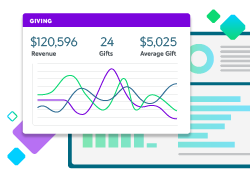Building a Complete Virtual Auction Toolkit: 5 Essentials

A virtual auction can bring many benefits for your organization. From expanding your nonprofit’s reach and making your events more accessible to donors all over the world to boosting your revenue, a virtual auction is a modern and exciting fundraising event that every nonprofit should consider adding to their calendar.
Like any fundraiser, an auction will require a thorough plan, dedicated software to streamline your donor management, and a way to effectively market your event and drive engagement even after your event is over. However, since your auction will be online, your nonprofit will need to go the extra mile to keep bidders engaged and create a memorable experience that will resonate with them, allowing you to meet and exceed your fundraising goals.
The right technology solutions can streamline the entire fundraising experience, easing your nonprofit’s administrative burden and leaving donors with a positive impression of your organization. Explore these winning solutions to make your next virtual auction the best event yet:
- Virtual Auction Software
- Live-streaming Tools
- An Underlying CRM or Database
- Digital Marketing Platforms
- Peer-to-Peer Fundraising Software
Backed by a strong technology foundation and fundraising plan, your organization will be in great shape to lead a successful virtual auction. Let’s begin.
1. Virtual Auction Software
To effectively manage your charity auction, you’ll need all your tools in one place. Comprehensive online auction software improves every aspect of the fundraising process, from sending personalized communications using your donor data to generating real-time analytics that measure engagement and fundraising progress.
Look for virtual auction software with the following features:
- Item procurement tracking. As you begin the item procurement process, it’s vital that your team maintains an organized list that tracks each item’s status. Work with virtual auction software that allows you to easily manage an item database and compile a complete item catalog that can be shared with bidders.
- Mobile bidding tools. Being able to accept, process, and track bids in real time is essential for success with any auction. Online auction software automates the entire process, and mobile bidding tools can boost engagement by making it easy for bidders to join from anywhere.
- Gamification. Creating friendly competition helps to immerse your remote guests into your event and encourage them to bid. Your online auction software should come with intuitive tools so you can easily generate scoreboards and fundraising thermometers to amp up the crowd. Plus, software with automated notifications can even let donors know exactly when they’ve been outbid, bringing them right back into the heat of the competition and motivating them to win the bid.
- Streamlined registration and checkout process. To improve the user experience, look for a provider that offers express check-in and self checkout options. This way, attendees can begin and close out their auction experience with ease right from their phones.
- Sponsor ticketing and tracking. To boost revenue for your event and ROI for your sponsors, look for auction software that offers a way to easily track paid and in-kind sponsorships as well as ways to match sponsor contributions to public displays, such as logo sizes.
Using robust online auction software will yield better results than cobbling together a piecemeal solution. If your bidders have to navigate between multiple platforms or your organization is forced to pore through spreadsheets of disorganized data, it’ll be much more difficult for your nonprofit to maximize success. Instead, offering a unified, intuitive bidding experience will generate more engagement and simplify your team’s planning.
2. Live-streaming Tools
Live-streaming gives your virtual event a more engaging, dynamic feel and opens up additional opportunities both to keep attendees interested and to ask for more support. Many virtual auctions occur as part of a larger virtual gala that incorporates live auction elements, direct donation appeals, multimedia presentations, and recognition ceremonies.
Even for a standalone virtual auction, hosting a live kickoff or grand finale event can be a good idea to create a more immersive experience for donors that they’ll remember, regardless of whether they won items or not.
Whatever the context of your online fundraising event, you’ll need livestreaming software to facilitate any live segments of your virtual auction.
Although there are plenty of free live-streaming options available online, using a comprehensive virtual fundraising platform that includes live-streaming features will deliver more value. Make it easy to tune into your livestream, browse your item catalog, place bids, learn about your mission, and make donations all in one virtual setting.
This virtual event center should serve as the anchor for your virtual auction, giving attendees a streamlined, fully branded experience rather than requiring them to jump between your fundraising activities and your livestreamed program.
3. An Underlying CRM or Database
Your nonprofit is likely already using a CRM or donor database solution to store, sort, and analyze your transaction and engagement data. If you’re planning a virtual event, make sure your CRM is part of the action and can readily integrate with your virtual auction software.
Your database will be useful at each step of the fundraising process:
- Before your virtual auction, use your CRM to help guide the planning process. For instance, create donor segments and study commonalities among your target audience to better target your item catalog to match their interests and price ranges. Generate contact lists and marketing segments for use in promoting your auction.
- During your virtual auction, engagement records and transaction data should report directly to your CRM if it’s integrated with your online auction software. Without an integration, data reporting will need to be completed manually after the event ends, although intuitive auction software should still provide easy-to-generate reports to simplify this process.
- After your virtual auction, study your engagement data and revenue totals. Post-event analysis yields many more insights and takes less time when your team is able to easily filter through data in your CRM. This data can also help guide the follow-up and stewardship processes, as you can quickly sort bidders by total contributions or other engagement metrics.
After a virtual auction, leverage your CRM to take a deeper dive into the individuals that gave the highest bids and identify ways for them to grow their impact. Promoting stock donations or your recurring giving program are great examples to inspire ongoing engagement to support your cause year round.
4. Digital Marketing Platforms
Like your database, this is another virtual auction tool that you likely already have at your disposal. Your digital marketing platforms will be essential for promoting your virtual event, generating interest and excitement, and engaging bidders before and during the big day.
According to NXUnite’s guide to nonprofit marketing, a multichannel marketing strategy can help you reach different audiences and acquire new donors. Consider developing high-quality content across the following platforms:
- Email. Highlight your upcoming auction in your monthly newsletter and give clear directions on how to register. Leading up to the event, make your messages more personalized by segmenting your audiences according to their donation frequency, recency, and amount. This way, you can effectively target donors of different giving levels and encourage additional donations before and during the event.
- Social media. Share announcements and teasers leading up to your virtual auction, and encourage nonprofit influencers with an interest in your cause to share your posts, too. Be sure to link directly to your virtual auction’s website or registration form. On the day of your event, incorporate live supporter shout-outs, photo contests, and Q&A sessions in your social media to add another level of engagement to your event.
- Nonprofit’s website. Spotlight your virtual auction on your homepage with bold CTAs that direct visitors to your auction website or event landing page. This way, they can easily learn about your event’s details and register without having to do too much digging.
As you generate marketing content, actively monitor metrics like email click-through rate, social media reposts, and conversion rate. This will help you understand the type of content that resonates most with your audience and where they’re spending their time so you can adjust your digital marketing strategies as needed.
5. Peer-to-Peer Fundraising Software
To generate even more support for your virtual auction, tap into peer-to-peer fundraising. Empowering your supporters to fundraise and promote your virtual auction on your behalf can help you reach much wider audiences, bringing in more revenue for your event and expanding your donor base even after your auction is over.
Launch a peer-to-peer campaign a month or two before your virtual auction is set to begin, and encourage supporters to create their own donation pages to share with friends and family. For a more strategic approach, try ambassador fundraising. According to the OneCause guide to peer-to-peer fundraising, ambassador fundraising involves actively recruiting well-connected ambassadors from your base of support. Then, empower them with helpful resources, individual registration pages, and engaging promotional multimedia content to share with their audiences.
Set specific donation and registration goals for your ambassadors, and periodically check in on their progress and offer support leading up to your virtual auction. This strategy is particularly effective for larger-scale events like virtual galas that include online auctions.
Be sure to publicly recognize and express your gratitude during and after the event. Consider sending thank-you letters that reference the specific impact the ambassador had on your fundraiser and how this will propel your mission forward.
Planning and managing a virtual auction can feel overwhelming if you’re not equipped with the right tools. To save your team time and streamline your auction management and execution, work with a leading virtual auction software that comes with a full-suite of user-friendly solutions. The right provider will make it easier than ever to boost engagement, drive amazing fundraising results, and build relationships with supporters that will continue even after your event is over.
The Nonprofit CRM Built for Fundraisers
Find out how Blackbaud’s Raiser’s Edge NXT® fits your organization.

